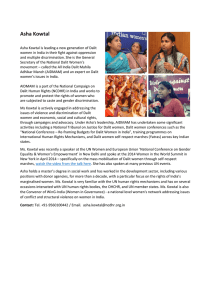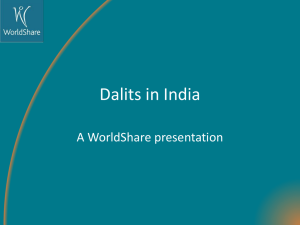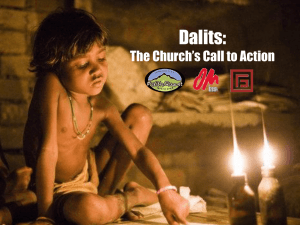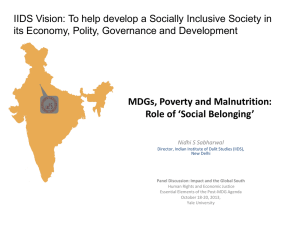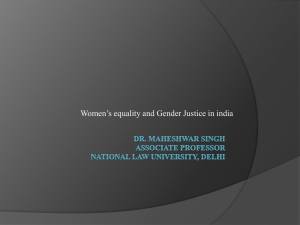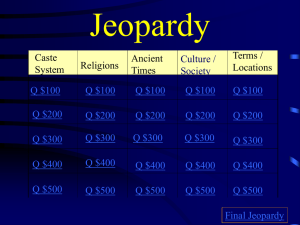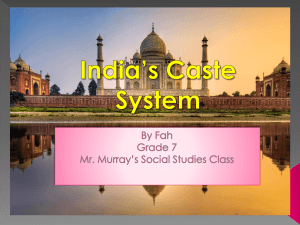NTU_Abstracts - Université Paul Valéry
advertisement
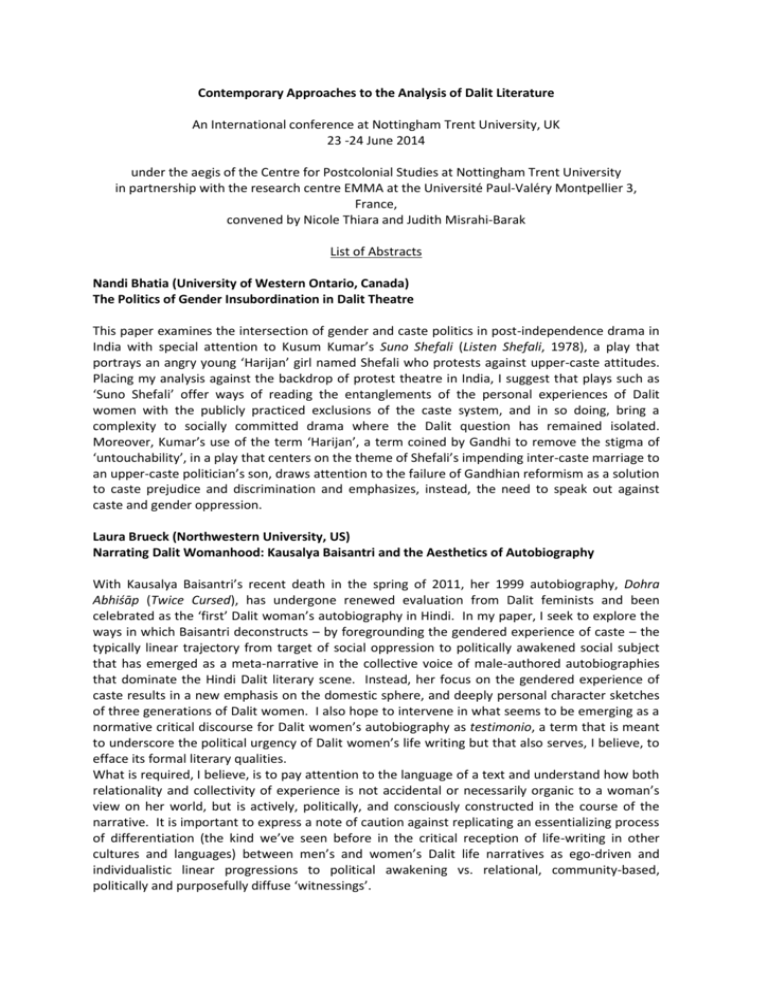
Contemporary Approaches to the Analysis of Dalit Literature An International conference at Nottingham Trent University, UK 23 -24 June 2014 under the aegis of the Centre for Postcolonial Studies at Nottingham Trent University in partnership with the research centre EMMA at the Université Paul-Valéry Montpellier 3, France, convened by Nicole Thiara and Judith Misrahi-Barak List of Abstracts Nandi Bhatia (University of Western Ontario, Canada) The Politics of Gender Insubordination in Dalit Theatre This paper examines the intersection of gender and caste politics in post-independence drama in India with special attention to Kusum Kumar’s Suno Shefali (Listen Shefali, 1978), a play that portrays an angry young ‘Harijan’ girl named Shefali who protests against upper-caste attitudes. Placing my analysis against the backdrop of protest theatre in India, I suggest that plays such as ‘Suno Shefali’ offer ways of reading the entanglements of the personal experiences of Dalit women with the publicly practiced exclusions of the caste system, and in so doing, bring a complexity to socially committed drama where the Dalit question has remained isolated. Moreover, Kumar’s use of the term ‘Harijan’, a term coined by Gandhi to remove the stigma of ‘untouchability’, in a play that centers on the theme of Shefali’s impending inter-caste marriage to an upper-caste politician’s son, draws attention to the failure of Gandhian reformism as a solution to caste prejudice and discrimination and emphasizes, instead, the need to speak out against caste and gender oppression. Laura Brueck (Northwestern University, US) Narrating Dalit Womanhood: Kausalya Baisantri and the Aesthetics of Autobiography With Kausalya Baisantri’s recent death in the spring of 2011, her 1999 autobiography, Dohra Abhiśāp (Twice Cursed), has undergone renewed evaluation from Dalit feminists and been celebrated as the ‘first’ Dalit woman’s autobiography in Hindi. In my paper, I seek to explore the ways in which Baisantri deconstructs – by foregrounding the gendered experience of caste – the typically linear trajectory from target of social oppression to politically awakened social subject that has emerged as a meta-narrative in the collective voice of male-authored autobiographies that dominate the Hindi Dalit literary scene. Instead, her focus on the gendered experience of caste results in a new emphasis on the domestic sphere, and deeply personal character sketches of three generations of Dalit women. I also hope to intervene in what seems to be emerging as a normative critical discourse for Dalit women’s autobiography as testimonio, a term that is meant to underscore the political urgency of Dalit women’s life writing but that also serves, I believe, to efface its formal literary qualities. What is required, I believe, is to pay attention to the language of a text and understand how both relationality and collectivity of experience is not accidental or necessarily organic to a woman’s view on her world, but is actively, politically, and consciously constructed in the course of the narrative. It is important to express a note of caution against replicating an essentializing process of differentiation (the kind we’ve seen before in the critical reception of life-writing in other cultures and languages) between men’s and women’s Dalit life narratives as ego-driven and individualistic linear progressions to political awakening vs. relational, community-based, politically and purposefully diffuse ‘witnessings’. Kalyan Das (Presidency University, Kolkata, India) Imagining ‘Bauriland’ – a Dalit Utopia(?) in 21st century (West) Bengal Dalit and other such subaltern movements have often been driven by a desire to establish an egalitarian world that would be free from exploitation and inequalities. Even before Thomas Moore discovered his vision of an ideal Christian commune in a ‘new’ world that he called Utopia, Ravidas (c 1450-1520), a ‘lower caste’ bhakti radical, imagined his own ‘utopia’ which would be a ‘casteless, classless, tax-free city without sorrow’. He called it ‘Begumpura’. Such Begumpuras, as shown by Gail Omvedt in her book Seeking Begumpura, have been reproduced in both colonial and post-colonial India. In my paper, I seek to look into the socio-cultural dynamics of a ‘utopian’ imagination envisioned by the Bauris in West Bengal. This community, with a history of being sandwiched between the caste Hindus and tribal communities, imagines a world that is ‘real’ and ‘unreal’ (hence utopian) at the same time. Such ‘real’ and ‘unreal’ spatiality often gets translated into literary texts and the heterotopian space of the virtual world as a result of political and cultural activism of Bauri poets, writers and playwrights. Apparently relying on an autochthonous reclaiming of the past and a sub-nationalist claim, such acts of imagination cannot be interpreted only in terms of their persistent faith in supposedly and allegedly ‘imported’ ideas of liberty, equality and fraternity. Tracing the localized evolution of such utopian imagination, my paper attempts to examine the cultural texts written by the Bauris and seeks to analyze them by implementing insights derived from Indian visions of ‘nowhere’ spaces, Foucault’s ‘Of Other Spaces: Utopias and Heterotopias’ and Renaissance humanism of Moore’s time. Santosh Dash (Arts and Commerce College, Savli, India) State, Imagination and the Dalit Vernacular In the last ten years or so one has seen a rearrangement of the political and literary mainstream in Gujarat. In the political domain, the idea of Suraj (good governance) is conjured up and offered as a desirable stage of historical development. The earlier ideas of Swadesh (pride in one’s country) and Swaraj (self government) that were in circulation during the heydays of high nationalism in India and which had a distinct vernacular trajectory in Gujarat now seem to have found their historical destination in this new idea of Suraj. The last ten years has also seen the emergence of the idea of Pratibadhatha (commitment) in mainstream Gujarati literature. There are debates among upper caste writers around the idea of what would really constitute ‘commitment’ in literature and whether it could be made at the expense of aesthetics. The earlier ideas of literary commitment which were in circulation during the time of Gandhi have come back with new vigour, definitely after the 2002 riots in Gujarat, to haunt the literary establishment with new questions. On the other hand, Dalit writers who had made a claim on the vernacular some forty years ago seem to have been leading the vernacular through sharp, critical interventions in the domain of literature. The Dalit vernacular has become a leading force not because of the self critique it has helped engender in the mainstream but because of the self assurance it has gathered through politically and conceptually sharp interventions in the social and economic life in Gujarat. My attempt in this paper would be to study a set of short stories published after 2002 in Dalit magazines like Hayati and Dalit Chetana in order to explore how Dalits in the state have portrayed their lives and how they have responded to the rhetoric of the state particularly at the time when the Hindu nationalist imagination is no longer speaking the language of Hindutva but is using the language of development, of Suraj and ‘Sauno saath, sauno vikas’ (support for all, development for all), seeking in the process, political legitimacy not only in the state but across India. Asis De (Mahishadal Raj College, West Bengal, India) The Aesthetics of Becoming a Being Autobiography Itibritte Chandal Jeevan (2012) in Manoranjan Byapari’s First Bangla The rise of Dalit voices in West Bengal in Eastern India has drawn the attention of academicians in recent past. Though Bangla Dalit literature has a long history (starting from the first decade of the twentieth century), leading contemporary Bengali Dalit writers like Manoranjan Byapari, Anil Gharai, Mahitosh Biswas, Kalyani Thakur Chanral, Jatin Bala, Sunil Das, Manohar Mouli Biswas are hardly known by the academic ‘elites’ even in India. The ‘guardians’ of Bengali academia have shown a strange indifference to Dalit literatures probably for the reason that they considered the caste-based literatures as something less dignified, lacking aesthetics and therefore, less deserving. Probably due to a long period of communist rule, the abolition of the system of landed aristocracy and the implementation of local democratic governance in the rural level earlier than other states in India, the scenario of the caste-based oppression, deprivation and social humiliation of the Dalits in West Bengal seems to be tuned in a rather low level. But the spirit of hypocritical victimization on the basis of class (‘bhadralok’/ ‘chhotolok’ binary) burns into flame as it includes the question of caste. In this paper I would focus on the first Bangla Dalit autobiography by Manoranjan Byapari— Itibritte Chandal Jeevan (2012), which could be considered as a representation of rage gathering impetus from an interplay between caste and class. Dalit autobiographical literature is basically a poetics of pain based on the politics of socio-cultural exclusion. In his personal narrative Byapari wages a war against the impotent political system which does not voice for the emancipation of the powerless, poor and the illiterate Dalit. I would also show how Byapari’s quest for an identity—both of a human being and a writer—has been expressed in his autobiography and how his exemplary odyssey opens up a new avenue in the world of Bangla Dalit literature. Toral Jatin Gajarawala (New York University, US) Caste, Complicity and the Contemporary Fiction This essay insists on two dueling frameworks: ‘caste’ and ‘contemporaneity’. Presumed to be mutually exclusive, one marked, the other clear and transparent, one putatively archaic, the other heralding the new, one evoking dirty realisms and realpolitiks, the other, the freedoms of abstraction. This essay will insist on the intertwining of caste and the contemporary in order to argue that the contemporary is a category constructed by and around caste, rather than a radical break from it, or a true Novum in the Blochian sense; the time/space of the contemporary is, in fact, in complicity with caste. This paper will consider the modalities via which caste politics makes itself visible in Dalit autobiography; in the diasporic Anglophone novel; in the contemporary Hindi novel, and in new Dalit fiction. Contemporaneity, as a concept, poses a theoretical problem; it is difficult to distinguish from modernity, but presumed to be secular, post-identarian and fleeting; most importantly, its globality is implicit. This is why in Ajay Navariya’s stories, the chaiwallah is glued to ‘an international channel, now showing pictures of Saddam Hussein’ while pursuing the vulture-like investigation of a passerby’s caste identity. Contemporaneity need not be progressive, in either sense of the word, but rather collagist. And in this implies its tragedy, which, though ringing with newness and emergence in the work of many postmodern theorists, is a problematic continuity of time past. In this essay, I argue for a consideration of the politics of the casteist contemporary, in order to complicate the basic aesthetic frameworks of realism and modernism that have emerged to consider Dalit literature. While the first section of the paper considers the ‘aesthetics of the contemporary’, and the use of collage, the second section considers a ‘politics of the contemporary’ and the question of ressentiment. I focus specifically on fiction and autobiography of the last decade, namely the Hindi short stories of Ajay Navariya [2004-2012], the Anglophone novel Serious Men [2010] by Manu Joseph, the Dalit autobiography of Narendra Jadhav [2003], written in English, and the eminent Hindi novelist Uday Prakash’s Peeli chatri wali ladki [2001]. Raj Kumar Hans (M. S. University of Baroda, India) Religious and Political Movements and the Making of Punjabi Dalit Literature By joining the anti-brahmanical Sikh religious movement in the Punjab from the 16th century, Dalits empowered themselves with literary skills and creative expressions. Four major Dalit intellectual poets had emerged in the process by 1925 which can be characterized as ‘pre-Dalit-consciousnesses’ phase in the subcontinent. Ad Dharm, a powerful autonomous Dalit movement (1925-1950), produced a number of Dalit poets and writers along with their own magazines. Freedom struggle movement, leftist movements including the radical Naxalite movement (1968-76), and Kanshi Ram’s BAMCEF (All India Backward and Minority Communities Employees' Federation) and Bahujan Samaj movements have differently influenced a number of Dalit litterateurs. However, the militant Khalistan movement for a separate Sikh state (1978-90) failed to sway any Dalit litterateur to its side. Dalit literature for that matter has remained part of the progressive movements throughout. To closely analyse this correlation the paper focuses on the two instructive autobiographical texts by Gurdas Singh Gharu (b. 1923) and Sarup Singh Sialvi (b. 1948). The former comes from a labouring Mazhabi Sikh family with a long record of struggles and the latter from a Ravidasia Chamar family of skilled leather-workers. While Gharu was a member of the Communist Party of India for 16 years and then of the Krantikari Sahit Sabha, a radical body of litterateurs, Sialvi was also influenced by Marxism and was an active member of the Ambedkarite BAMCEF. Memory-history interface is strong in both the writers and they take us to the unknown pages of dalit history. A conscious effort to move from ‘memory’ to ‘history’ is discernible with them. Caroline Herbert (Leeds Metropolitan University, UK) Life and Labour in Bombay: Dalit Writing in Urban India This paper examines literary representations of urban poverty, ad hoc housing, slum-dwelling, and in/formal circuits of labour, centering on poetry and prose fiction by, and about, Bombay/Mumbai’s Dalit communities, in English and in translation. I explore the significance of tropes of the spectral, and of visibility and invisibility to representations of the material experiences of life and labour of those often positioned as ‘non-citizens’ in the city. Dalit communities and artists have been central to Bombay’s industrial, economic, cultural and political development. In the late 1960s and 1970s, Bombay/Mumbai was a key site of Dalit political activism and literary creativity, with the formation of the Dalit Panthers in 1972 by a group of writers and intellectuals. Yet discussions Bombay/Mumbai, of urban India, and of postcolonial urban modernities by literary critics – in the Western academe at least – have tended to marginalize creative outputs by Dalit writers and artists in favour of Anglophone, ‘cosmopolitan’ writers (Rushdie, Chandra, Mistry). For many rural Dalits, Bombay/Mumbai promised emancipation from caste hierarchies of the village, a promise tempered by experiences of economic exploitation and housing poverty upon arrival. In this light, Dalit writers often articulate Bombay/Mumbai as an ambivalent site of refuge, but also of social injustice and exclusion, bringing into doubt the extent to which the city shares its wealth with those who labour to bring it into existence. I explore these through work by writers such as Anna Bhau Sathe, Baburao Bagul, and Namdeo Dhasal). Reading poetry alongside short stories I consider different strategies for representing Bombay’s urban poor, their experiences of urban inequalities, and economies of urban space and citizenship. Lakshmi Holmström (Independent researcher and translator, UK) Bama and Sukirtharani: Language Strategies in the Protest Literature of Tamil Dalit Women With the publication of Bama’s autobiography, Karukku in 1992, Tamil Dalit writing enters a new phase: that of Dalit Feminism. Both Karukku and Sangati (1994) bring to Tamil writing a number of language strategies, which overturn a mainstream aesthetic and propose a new one integral to Bama’s politics as a Dalit woman and a Christian. Some of these strategies are: a consistent use of the colloquial, the reclamation of a cultural frame of reference which is based on oral tradition, the use of ridicule or lampooning as a means of subversion, and the foregrounding of the use of transgressive language by women as a means of self-defence. Continuing the same language project, the poet Sukirtharani, fifteen years younger than Bama, has written that she seeks an ‘infant language’, baalya mozhi, still ‘sticky with blood’, a sensual language in which she maps a Dalit world and history through the sensitive reading of a Dalit woman’s body and her sexual self. Thus Sukirtharani brings a Dalit dimension to the new poetry by Tamil women and its exploration of the politics of sexuality. Together, these new language strategies constitute what I have termed the ‘Dalitization’ of Tamil writing. Teresa Hubel (Huron University College, Canada) Tracking Obscenities: Dalit Women, Devadasis, and the Linguistically Sexual In his 1993 Dalit Panpaadu, Raj Gauthaman declares that Dalit writing should ‘outrage and even repel the guardians of caste and class’. Writing by Dalit women has been exceptionally successful in achieving this goal, particularly in its representation of the sexuality and sexually-charged language of Dalit women. For instance, in her extraordinary novel/autobiography/short-story collection Sangati (2005), Tamil author Bama represents the difficult and often deeply moving lives of Dalit women in south India. Although multiply subversive, Sangati seems to me to be the most outrageous in its exposure of the sexual violence that often underpins the language of her female characters. Similarly, in her oral autobiograpy (1997) Viramma repeatedly speaks in ways that suggest her embrace of that which, from an upper-caste and middle-class perspective, might seem tasteless and vulgar, especially since it issues from the mouth of a woman. In my paper I theorize this use of sexual language, arguing that it represents a deliberate challenge to the norms for respectable, middle-class femininity. Although it could certainly be also interpreted as a sad product of patriarchal and caste oppression, as Bama herself has read it, I suggest that it is also a powerful disruption of the feminine that refuses to play to patriarchal expectations about the necessary decorousness of the feminine, and, as such, it models a defiance that mainstream feminism, rooted as it has been in predominantly middle-class values, might very well copy. To understand the contours of this defiance, my paper compares Dalit women’s sexual language to other forms of Indian feminine sexuality in texts such as Kamala Das’s My Story and in the lyrics to songs that are interpreted in dance by devadasi artists, who may or may not be considered Dalit. Malarvizhi Jayanth (University of Chicago, US) Dalit literature and Journalism in Tamil and Malayalam This paper argues for reading the Dalit journalism and literature produced in late-19th century and early 20th century south India as produced by and formative of the Dalit political struggles of the time. Dalit literature and journalism in Tamil and Malayalam from this period has received very little scholarly attention despite its importance for the history of anti-caste struggle and the history of literary production from communities historically denied literacy. In this period, Dalit leaders in Madras Presidency and the princely state of Travancore began to re-interpret history to understand the origins of caste, mobilize the early labor movements, wield religious conversion and reform as modes of political protest and lead the first protests against gendered caste practices. Novels such as Saraswati Vijayam (1892) by Potheri Kunhambu (1857-1919) in Malayalam, the journalism of Tamil scholars like Ayothee Thass (1845-1914), biographies of Ayyankali (1863-1941) and the work of Tamil leaders such as M.C. Raja (1883-1943) and Rettaimalai Srinivasan (1860-1945) in the Legislative Assembly draw upon this history and offer substantial proof of the formation of the Dalit political subject in print. Reading south Indian Dalit history and literature in both Tamil and Malayalam, I argue, first, that Dalit literary production enables the articulation of a political identity in opposition to caste and issued a major challenge to gendered caste practices in the region. Secondly, I illustrate that in the late 19th and early 20th century, both Tamil and Malayalam literature remained in conversation with one another, thus also illuminating inter-lingual conversation and examining the ways in which it enabled an emancipatory politics. Devika Mehra (Jamia Millia Islamia, Delhi, India) Politics of Emergent Dalit Writings for Children: Whose Childhood and For Whom? Childhood has been constructed in multiple ways in tandem with macro-structural flows in society. Children’s literature, itself, constructs the world of and for the child. In recent years, new texts have been published that represent the ‘lived experience’ of the child from the marginalized section and that aim to introduce children to caste-based conflicts, having gained impetus from NGOs and publishing houses such as Left-Word, Navayana, Tulika, Katha among others. These texts namely Kancha Ilaiah’s Turning the Pot, Tilling the Land, Bhimayana: Experiences of Untouchability by Srividya Natrajan and S. Anand, A Gardener in the Wasteland by Srividya Natarajan, and picture-books such as Kali and the Rat Snake by Zai Whitaker, The Why-Why Girl by Mahasweta Devi among others work as counter-narratives providing renewed ways of re/presenting childhood, even as they bridge a gap between fictional constructions and actual lives of children, especially those from the margins across the world. But the question that comes up is whose childhood is being constructed and for whom? Is there a divide between the child reader and the fictional child? Do these texts reach the child from the margins or are they for a niche readership? If yes, what role do they play keeping in mind the benefit of bibliotherapy in helping children cope with their problems? What is the role of the publishers and NGOs? These are some of the issues that I intend to take up in my paper. While addressing issues related to emergent aesthetics of Dalit writings for children, I am going to look at these fictional constructions and look at the relation between the child-signifier and the child-reader. Christi Merrill (University of Michigan, US) Beyond the Commodification of Experience or, What’s the use of literary device in nonfiction writing? As an academic translator who has begun rendering Dalit autobiography from Hindi into English and as an instructor who often teaches them, I am especially interested in debates about the politics — as well as ethics — of translating first-person accounts. Pramod K. Nayar has argued that reading Bama’s Karruku as ‘testimonio’ rather than autobiography promotes an experience of what he calls ‘secondary witnessing’ that creates ‘possibilities for solidarity and affiliations among critics, interviewers, translators and the subject who ‘speaks’. In this paper I would like to ask what lessons we might draw from the comparison between Dalit writings and Spanishlanguage testimonio such as Rigoberta Menchu’s. I am particularly interested in Anuradha Dingwaney and Carol Maier’s prescient warning against readers’ over-identifications with ‘the oppressed, subaltern subject’. How do the generic expectations of these writings influence our perception of these works’ political and aesthetic value when marketed in India and abroad as works of world literature? What do we expect these accounts to offer beyond – in Joan Scott’s important formulation – the evidence of experience? I would like to pursue the comparison between Rigoberta Menchu’s testimonio and Dalit life narratives (in particular, Kausalya Baisantri’s ‘jivan ki katha’, Dohara Abhishap, which I am currently translating) in order to raise praxis-oriented questions about the ways we might finesse the rules of these genres in translation more adroitly. How might academic translators and literature scholars effectively represent these narratives of individual and collective suffering beyond simplistic stereotypes about the realities of the victim? I am particularly interested formulating a response to textual moments that demand a more complex reading, and thus that challenge the reader (and translator) in ways both political and aesthetic. Ajay Navaria (Jamia Millia Islamia University, Delhi, India) Dalit Identity and the Urban Space (keynote) The history of caste system in India is very ancient. It is so ancient that it is left to imagination and conjectures. There are many ways to know the history of Indian society. One can also explore it through the religious scriptures. There were many religions and their religious scriptures in ancient India. Only Vedic religion, not any other religion like Buddhism, Jainism and Aajivakas, gave approval to the Varna vyavastha (System of Varna). It has been declared Divine (not made by human) by Vedic tradition. Indian society is roughly divided into three inhabitant sections: Rural society, Township (Qasba) society and urban society i.e. Metropolitan society. This paper will trace the journey of Dalits from ancient India to the contemporary time. It will emphasize upon the differences of life of Dalits in villages and metropolitan cities, and the kind of liberty and happiness enjoyed by Dalit communities as well as the kind of hardships and discriminations, they faced in metropolitan cities. Reservation is a constitutional measure, which created a tremendous change in the life of Dalit communities. It uplifted the standard of poor Dalits into a lower middle or middle class Dalits by including them in government services as employees and officers. The process of privatization in India has tried to fade the movement of identity by not giving white-collar jobs to the Dalits if they disclose their social identity. Dalits are helpless to disclose their identity and live in fear of revealing it. This leads them to anonymity. They become stranger to their own families and relatives to secure their jobs in private sectors. They go through a lot of psychological pressures in private sectors. The focus of this paper is to analyse different shades and stigmas of Dalit Identity in urban space. It will also analyse whether metropolitan life is only a boon to the Dalit communities or it creates curses too. K. Satyanarayana (EFL-University, Hyderabad, India) The Revolutionary Function of Dalit Writing: Some Contemporary Approaches (keynote) Dalit writing did not attract a sustained critical attention from literary critics, commentators and academics. Often Dalit writing is read as a new literature that portrayed the social life from the margins (the excluded and suppressed Dalit castes) of Indian society and therefore, it expanded the canvas of Literature. It is also uncritically ‘included’ in the canon of Indian literature. These processes of appropriation undermine the Dalit critique of the category of Literature and the canon of Indian literature and obfuscate the political and aesthetic significance of Dalit writing. A brief overview of some contemporary approaches to the study of Dalit writing may help us outline some issues for discussion. Marathi Dalit critic and writer, Baburao Bagul, attempts a critical review of Indian literary history and observes that ‘the established literature of India is Hindu literature’ and that the ‘lowest’ castes are excluded in Indian literature because of its Hindu character. He explains that the Indian writers imbibed ‘the Hindu value-structure’ and that they would not accept the ideas (‘heroes, themes and thoughts’) from the anti-caste ideologies of Phule and Ambedkar. Dalit literature, Bagul and other Dalit critics demonstrate, represents a new thinking and a new point of view. It poses the question of the representation of Dalit and ‘lower’ caste life as a critical issue. Bagul posits the conflict between Indian (Hindu) literature and Dalit (human) literature as a central issue in Indian literary history. He claims the legacy of Buddha, Christ, Phule, Ambedkar and also the Western Enlightenment for Dalit literature. In The Flaming Feet, D R Nagaraj describes Dalit literature as ‘an expression of Ambedkarite cultural politics.’ The Ambedkarite strand in Dalit literature, Nagaraj observes, gives expression to anger, self-pity and hope of the untouchables. This is the school of ‘Social Rage’ and it employs social realism (the rationalist and empirical world view) as a mode of narration. The limitation of this writing, Nagaraj argues, is that it constructs Dalit identity as a political identity based on experiences of exploitation and violence but rejects ‘the traditional cultural self of Dalits steeped in the Hindu ethos.’ The larger problem is that Dalit literature denies Dalits the resources of cultural and spiritual life. This is really the problem of the Dalit movement which located itself in the project of modernity and totally rejected ‘the traditional society.’ The school of ‘Spiritual Quest,’ according to Nagaraj, attempts to explore ‘the symbolic and religious life of lower castes’ and creativity in Hindu folk culture. This ‘traditional’ cultural life would enhance self-respect of the Dalit communities. Nagaraj locates Dalit literature in the sphere of Indian culture and therefore, argues for ‘a new poetics of Indian culture.’ This approach constructs a dichotomy between tradition and modernity and posits an authentic Dalit identity in the past. In a recent study, Toral Jatin Gajarawala argues that Dalit fiction redeploys social realism of the Indian progressive writers. Dalit realism, she asserts, offers a bifurcated vision of Indian society: both the subjection (the real) and liberation of Dalits (the ideal). She rightly criticizes the common sense reading of Dalit literature as an unmediated reflection of Dalit identity and politics. The important move in this study is to analyse caste as ‘a literary-aesthetic’ which is very different from caste as lived reality or experience. It is clear that the aim of Dalit writing is not simply revealing the conditions and problems of Dalits. The studies indicate the transformative cultural and political agenda of Dalit writing: critique of Hindu feudal culture, Indian literary history, re-construction of cultural life of the untouchable castes and reformulation of modernity and its literary culture. A discussion of some of the key issues: representation, modes of writing, reconfiguration of modernity and visions of a democratic society might enable us to understand the theoretical innovation and the historical and current significance of Dalit writing. Bijaya Kumar Sethi (Indian Institute of Technology Indore, Madhya Pradesh, India) From Experience to Aesthetics: A Dalit Perspective It has always been a challenging task for new voices to create a space for themselves in the mainstream literary canon. Dalit literature is often dismissed by mainstream critics as they find it non-literary and devoid of literary aesthetics, because it deals only with caste exploitation and humiliation. Shrawan K Sharma argues, ‘Dalit writer fails to be impersonal’ and N. S Phadke, proclaims that, ‘the kind of contexts and events that are needed to add color to a novel are not found in Dalit lives’. Such contentions against Dalit literature bring an urgency for a legitimate analysis of the question of what literary aesthetics really means, i.e. whether is it a fixed structure of universal literary codes invariably applicable for the aesthetic assessment of every genre, or the aesthetic assessment of every literary piece varies in relation to its genre and the context in which it is being analyzed. The paper will use Stein Haugom Olsen’s article ‘Literary Aesthetics and Literary Practice’, ‘reader response theory’ and Walter Benjamin’s essay ‘The Work of Art in the Age of Mechanical Reproduction’ as the theoretical tools, to establish the argument that the aesthetic features of every literary genre are not the same, rather each literary genre has different aesthetic attributes which are conditioned to the kind of problem the genre deals with, and with the same token, Dalit Literature has its own aesthetic values. Finally, it brings in Gopal Guru’s discussion on “lived experience” and Sharankumar Limbale’s representation of selfconsciousness, caste consciousness, anger and protest as the basic feature of Dalit Aesthetics. The paper further analyses how these aesthetic elements are used in the Dalit autobiographical narratives such as Limbale’s Akkarmashi (1984), Omprakash Valmiki’s Joothan (1997) and Aravind Malagatti’s Government Brahmana (1994).
